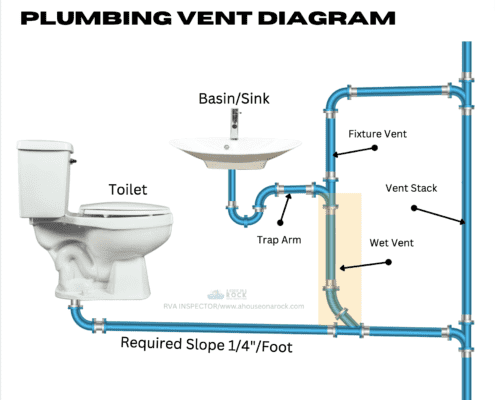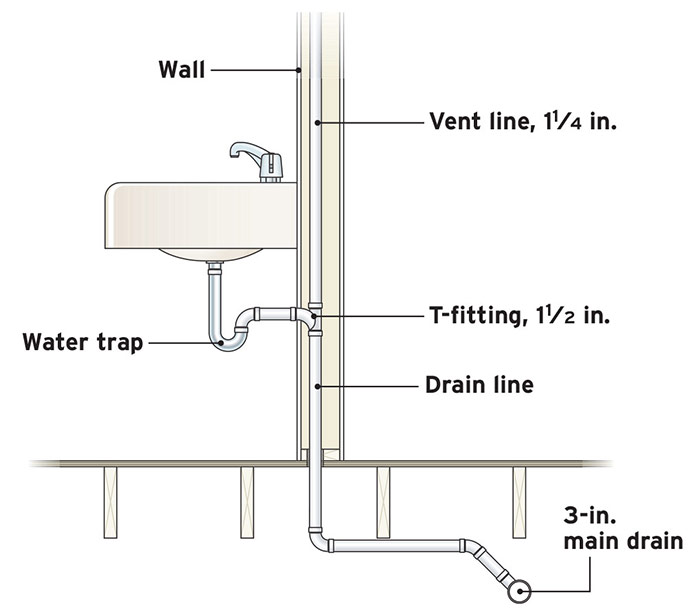Understanding The Importance of Proper Ventilation in Plumbing Systems
Understanding The Importance of Proper Ventilation in Plumbing Systems
Blog Article
The article underneath about What Is a Plumbing Vent and Why Is It Important is fairly attention-grabbing. Check it out yourself and figure out what you think about it.

Correct air flow in plumbing systems is frequently overlooked, yet it is vital for maintaining the capability and security of your home's plumbing. Ventilation aids control air pressure, protect against the buildup of harmful gases, and ensure the effective removal of waste. In this guide, we will explore the importance of proper plumbing air flow, exactly how it functions, and the advantages it brings to your plumbing system.
Just How Air Flow Works in Plumbing Equipments
Atmospheric Pressure Law
Correct ventilation preserves well balanced air pressure within the pipes system. When water moves through pipelines, it displaces air. Without adequate ventilation, this variation can create negative pressure, bring about slow drains or siphoning of water from catches, which can cause unpleasant smells to leak into the home.
Protecting Against Sewage System Gas Build-up
Among one of the most vital functions of plumbing vents is to avoid drain gases, such as methane and hydrogen sulfide, from building up within the home. These gases can pose serious health threats and are highly flammable. Vent pipelines enable these gases to leave safely outside.
Aiding in Waste Elimination
Air flow assists in the reliable elimination of wastewater by stopping airlocks in the drain system. When air can flow freely with the vents, it permits water and waste to move smoothly via the pipes, lowering the danger of clogs and back-ups.
Advantages of Proper Ventilation
Enhanced System Effectiveness
Effectively aerated plumbing systems operate more successfully, with fewer blockages, faster draining pipes, and much less pressure on the pipelines. This effectiveness extends the life-span of the plumbing system.
Improved Air Quality
By preventing sewage system gases from entering your home, appropriate air flow contributes to much better interior air quality, making your living atmosphere healthier and extra comfy.
Avoiding Water Damages
Adequate ventilation aids prevent water from being siphoned out of catches, which can result in sewage system gases entering the home and causing water damages with time.
Steps to Make Certain Proper Ventilation
Consulting Pipes Codes
Always seek advice from local pipes codes when developing or changing your plumbing system. These codes provide the essential standards for proper venting and ensure your system fulfills safety and security standards.
Normal Examination and Upkeep
Regular assessments can aid determine potential ventilation problems prior to they come to be major problems. Maintenance tasks, such as cleaning up air vent pipelines and looking for blockages, are essential for keeping the system in good working order.
Professional Installment
For brand-new installments or significant modifications, it's a good idea to work with an expert plumbing technician. They have the experience to make sure the air flow system is properly designed and set up according to code.
Understanding Ventilation in Plumbing
Air flow in pipes refers to the network of pipes that enable air to stream through the drain system. These vents offer multiple purposes, consisting of regulating atmospheric pressure within the pipes, protecting against sewage system gases from going into the home, and aiding in the smooth flow of wastewater.
Sorts Of Pipes Vents
Main Stack Vent
The main stack air vent, likewise referred to as the vent pile, is the main vent in a plumbing system. It extends from the major drain align via the roofing, allowing gases to get away and fresh air to enter the system.
Branch Vent
Branch vents link to the primary stack vent and offer specific components, such as sinks, commodes, and showers. These vents make certain that each fixture has sufficient air flow to operate correctly.
Air Admittance Valve (AAV).
An Air Admission Valve (AAV) is a one-way shutoff that allows air to get in the plumbing system without the need for a traditional vent pipeline extending through the roof covering. AAVs are typically used in restorations or areas where setting up a conventional vent is impractical.
Indications of Poor Air Flow in Plumbing.
Slow Draining Fixtures.
If your sinks, bathtubs, or commodes are draining pipes slowly, it could be a sign of bad ventilation. Insufficient air circulation can create a vacuum cleaner result, making it challenging for water to drain pipes properly.
Gurgling Appears.
Gurgling noises originating from drains are commonly an outcome of air being sucked with water catches as a result of unfavorable stress in the pipelines. This is a clear indication of insufficient air flow.
Unpleasant Odors.
Drain smells inside your home are a red flag that your pipes system is not appropriately ventilated. This could imply that sewage system gases are not being sufficiently vented outside, leading to possibly unsafe conditions.
Typical Air Flow Errors.
Poor Vent Sizing.
Utilizing undersized air vent pipes can lead to bad air circulation and pressure discrepancies in the system. It's important to make use of vents that meet the specific demands of your plumbing system.
Improper Vent Positioning.
Putting vents also much from the fixtures they offer can reduce their efficiency. Proper placement makes sure that air can stream easily and efficiently through the system.
Ignoring Code Requirements.
Building regulations give particular guidelines for pipes air flow. Neglecting these codes can result in a system that fails to operate properly and may result in expensive fixings or carcinogen.
Final thought.
Correct ventilation is a crucial element of any kind of pipes system, ensuring that it functions effectively and safely. By comprehending the relevance of air flow, recognizing the signs of poor ventilation, and taking actions to keep your system, you can protect against costly issues and protect your home's air quality.
4 Things You Should Know About Your Plumbing Vents
What Plumbing Vents Are
Also called a vent stack, a plumbing vent is a vertical pipe attached to your drain line that runs through your roof. The plumbing vent pipe, or plumbing air vent, removes gas and odors from your plumbing system and allows fresh air to enter the pipes, helping the water to flow out of the drain pipes.
What Plumbing Vents Do
Plumbing vents have two basic functions. One of which is to allow unpleasant smelling wastewater and sewer gasses to escape your plumbing system instead of entering your home. Plumbing vent pipes are typically located on roofs, away from windows, to ensure the fumes exit the home completely.
The other function of the plumbing vent is to move fresh air into your plumbing system. This helps move water through every plumbing fixture in your house, like toilets and sink drains. Think of the way in which you need to let a little air into the bottle as you pour soda in order to make the drink flow smoothly.
Different Types of Plumbing Vents
True vent: This is the most common vent option. In simplest terms, a true vent is a vertical pipe attached to your drain line that exits through the roof. They often function as the main vent that other fixtures can connect to. Re-vent pipe or auxiliary vent: Attached to the drain line near specific plumbing fixtures, re-vent pipes run up and over to connect to the main vent. Common vent: Two plumbing fixtures installed on opposite sides of a wall are typically tied into the vent stack using something known as a sanitary cross. Wet vent: This venting option operates as a drain pipe and a vent at the same time. Wet vent drainage systems drain water from one fixture while venting the air from another. Although they’ve been used for over 100 years, wet vent systems have only recently been added to the plumbing code in many areas. If you’re planning on installing one in a bathroom remodel, make sure you check your local code prior to construction. Loop vent: For free-standing fixtures like kitchen island sinks, loop vents are ideal. These vent pipes run under the floor, rise from the P-trap, and create a loop inside the cabinet sink. Air admittance valve: An AAV is a one-way mechanical valve typically installed at the site of the plumbing fixture. AAVs allow venting to occur without having to tie into a larger venting system. They’re ideal for venting fixtures where you aren’t able to easily connect to an existing vent system. Common Plumbing Vent Issues
Although vent pipes typically don’t have water flowing through them, they’re still subject to many typical plumbing issues. For example, clogs are one of the most common problems associated with sewer vent pipes. If your vent pipe gets clogged, all of your plumbing fixtures tied into the vent stack will be affected.
A sink with a slow drain that bubbles and gurgles or a strong sewage smell around your toilet are both indicators that your toilet vent pipe is clogged. Because most vent pipes exit through the roof, old leaves, twigs or even a bird’s nest could be clogging the pipe.
Clogs in your vent pipe system cause a buildup of negative pressure, meaning that water won’t be able to flow out of your home very well. It’s similar to putting your finger over the opening of a straw to trap water inside. When you remove your finger, the water is able to flow out of the straw.
If you suspect you have any blockage in your vent, make sure you have a professional come examine the situation. Left unchecked, a blocked air vent can lead to other costly repairs, like leaks and sediment buildup.
Under Pressure
Pipe vents are essential aspects of a home’s plumbing system. Owning a home means learning about all sorts of things you never put much thought into before. But by understanding as much as you can about the important systems of your home, you can keep those budgets intact and those anxiety levels low.
https://www.homeserve.com/en-us/blog/home-improvement/plumbing-vents/

I stumbled upon that entry about The Upsides of Proper Ventilation in Plumbing Design while doing a lookup on the search engines. I beg you take the time to distribute this write-up if you enjoyed it. We treasure your readership.
Call Today Report this page